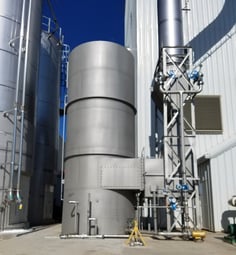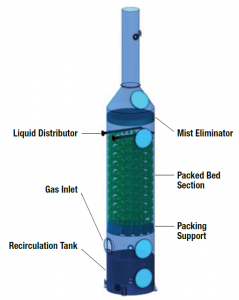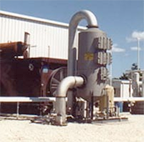A wet scrubber is a mechanical system that removes pollutants from an air stream by bringing it in contact with a scrubbing liquid, most often water. Wet scrubbers are generally the only single air pollution control device that can remove both particulates and gases/vapors. They are highly efficient at capturing the smallest dust particles and can eliminate more than 99% of airborne particulate matter by capturing them in liquid droplets. Wet scrubbers that remove gaseous pollutants are also referred to as absorbers.
Wet scrubbers are used in a wide range of industries, from acid, fertilizer and asphalt plants to steel mills and power plants. They offer an alternative to baghouses and other dry dust collection approaches; they’re often used for controlling exhaust from process equipment or they can be located downstream from baghouses/cartridge filter systems, furnaces, dryers, mixers, bucket elevators, bagging stations, and other emission points.
How wet scrubbers work
The four most commonly used types of wet scrubbers are Impinjet® wet scrubbers, venturi scrubbers, eductor venturi scrubbers and packed towers:
- Impinjet® wet scrubbers collect particulates and clean, cool and absorb vapors and gases. They offer high collection efficiencies (99% for particles 5 microns or larger) with low water consumption and minimum pressure drop. Impinjet scrubbers are highly resistant to fouling and available with capacities as high as 200,000+ CFM. Impingement plate (or tray) scrubbers use a flowing bed of water across a perforated surface. The airflow is drawn into the scrubber and passes through the plate water. The water traps the contaminants, removing them from the airstream. Impingement plate systems typically use lower energy /lower pressure drop to scrub the gas. Impingement scrubbers are suitable for particulate scrubbing and applications where both particulate and gaseous contaminants must be collected.
 Venturi scrubbers with cyclonic separators are often the best choice for high-efficiency collection of fine particulates. They use the differential between high-velocity gases and free-flowing water to create droplets that entrap contaminants, hold them in suspension and deliver them as a suspended solids solution. The venturi scrubber design requires more water and higher pressure drop to remove particulate than impingement plate scrubbers. The converging section of the venturi throat (where the water and airstream merge) creates atomized water droplets to provide efficiencies of 99 percent on particles 1 micron in size and larger. The efficiency can increase to 99.8 percent for particles 5 microns and larger.
Venturi scrubbers with cyclonic separators are often the best choice for high-efficiency collection of fine particulates. They use the differential between high-velocity gases and free-flowing water to create droplets that entrap contaminants, hold them in suspension and deliver them as a suspended solids solution. The venturi scrubber design requires more water and higher pressure drop to remove particulate than impingement plate scrubbers. The converging section of the venturi throat (where the water and airstream merge) creates atomized water droplets to provide efficiencies of 99 percent on particles 1 micron in size and larger. The efficiency can increase to 99.8 percent for particles 5 microns and larger.- Eductor venturi scrubbers remove both soluble gases and particulates by inducing a gas flow using high-pressure liquid focused into a venturi throat. This eliminates the need for a separate exhaust fan or blower to transport the contaminant-laden airstream to the filtration device. Eductor venturi scrubbers can also be used for direct-contact condensation. A high liquid flow rate makes this type of scrubber particularly well-suited for collecting sticky and/or gummy particulate, as well as gases that decompose on contact with water. Eductor scrubbers are often used in combination with other collection devices such as packed tower scrubbers.
 Packed towers are designed for chemical scrubbing of gaseous contaminants and are often used to remove sulfur dioxide, hydrogen chloride, ammonia, hydrogen sulfide, and other gases. In vertical scrubbers, the gas flows upward through the bed, while the liquid trickles downward by gravity through the packing, which is typically made up of small plastic or metal objects. The liquid wets the surfaces of the packing materials, which are designed to provide a large amount of surface area for contact between gas and liquid. A liquid distribution header located above the packing evenly distributes the scrubbing solution across the top of the packing. Recirculated scrubbing liquid typically contains alkaline, acid, or oxidizing scrubbing agents to achieve the desired outlet emissions. Prior to leaving the scrubber, the scrubbed air passes through a mesh or chevron style mist eliminator to remove entrained droplets.
Packed towers are designed for chemical scrubbing of gaseous contaminants and are often used to remove sulfur dioxide, hydrogen chloride, ammonia, hydrogen sulfide, and other gases. In vertical scrubbers, the gas flows upward through the bed, while the liquid trickles downward by gravity through the packing, which is typically made up of small plastic or metal objects. The liquid wets the surfaces of the packing materials, which are designed to provide a large amount of surface area for contact between gas and liquid. A liquid distribution header located above the packing evenly distributes the scrubbing solution across the top of the packing. Recirculated scrubbing liquid typically contains alkaline, acid, or oxidizing scrubbing agents to achieve the desired outlet emissions. Prior to leaving the scrubber, the scrubbed air passes through a mesh or chevron style mist eliminator to remove entrained droplets.
Wet scrubber applications
 Applications for wet scrubbers typically fall into one or more of four categories:
Applications for wet scrubbers typically fall into one or more of four categories:
- Combustible/hazardous dusts often call for wet scrubbers because they can effectively minimize the risk factors for a dust explosion. However, wet scrubbers are not appropriate for handling all dust types; some dusts (such as alkali metals like lithium, sodium and potassium and alkaline earth metals like beryllium, magnesium and calcium) are actually water reactive, which means they’re more hazardous when they come in contact with water.
- Moisture in the gas stream will foul or plug a dry dust collector and cause caking on the filter bags, but a wet scrubber can handle it without problems. Given that the scrubber uses water or another scrubbing liquid to saturate the gas stream for particulate removal, moist process gas is no problem.
- High-temperature applications represent another area where wet scrubbers offer a good solution. Unlike dry collectors, which require special high-temperature design and construction methods and expensive high-temperature filter bags, standard wet scrubbers can handle high process temperatures without these added costs. Because adding water into the system does not affect scrubber operation, quench systems can be employed prior to the inlet to the scrubber. A scrubber design that includes a pre-quench section can handle temperatures higher than 2,000°F.
- The combination of particulate and gaseous contaminants is particularly problematic for dry collectors because they can only address the solid particulates; a secondary piece of equipment, such as a scrubber, is also needed to remove the gases. In contrast, many types of wet scrubbers can collect both solid and gaseous components from the waste stream with just one piece of equipment.
To learn more about how a wet scrubber can boost your dust, vapor, and gas collection efficiency and save you money, download a free copy of Sly’s Wet Scrubber Application Guide. If you need advice on choosing the right scrubber design type for your process, contact the Sly sales representative nearest you.
Tags: wet scrubber




